 W
WScandinavian Scotland refers to the period from the 8th to the 15th centuries during which Vikings and Norse settlers, mainly Norwegians and to a lesser extent other Scandinavians, and their descendants colonised parts of what is now the periphery of modern Scotland. Viking influence in the area commenced in the late 8th century, and hostility between the Scandinavian Earls of Orkney and the emerging thalassocracy of the Kingdom of the Isles, the rulers of Ireland, Dál Riata and Alba, and intervention by the crown of Norway were recurring themes.
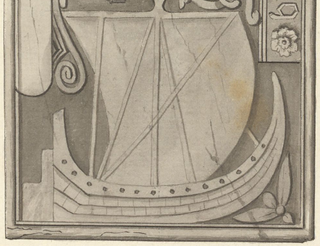 W
WThe birlinn was a wooden vessel propelled by sail and oar, used extensively in the Hebrides and West Highlands of Scotland from the Middle Ages on. Variants of the name in English and Lowland Scots include "berlin" and "birling". The Gallo-Norse term may derive from the Norse byrðingr. It has been suggested that a local design lineage might also be traceable to vessels similar to the Broighter-type boat, equipped with oars and a square sail, without the need to assume a specific Viking design influence. It is uncertain, however, whether the Broighter model represents a wooden vessel or a skin-covered boat of the currach type. The majority of scholars emphasise the Viking influence on the birlinn.
 W
WThe Battle of Brunanburh was fought in 937 between Æthelstan, King of England, and an alliance of Olaf Guthfrithson, King of Dublin; Constantine II, King of Scotland, and Owain, King of Strathclyde. The battle is often cited as the point of origin for English nationalism: historians such as Michael Livingston argue that "the men who fought and died on that field forged a political map of the future that remains [in modernity], arguably making the Battle of Brunanburh one of the most significant battles in the long history not just of England, but of the whole of the British Isles."
 W
WClan Gunn is a Highland Scottish clan associated with lands in northeastern Scotland, including Caithness, Sutherland and, arguably, the Orkney Isles. Clan Gunn is one of the oldest Scottish Clans, being descended from the Norse Jarls of Orkney and the Pictish Mormaers of Caithness.
 W
WThe Crovan dynasty, from the late 11th century to the mid 13th century, was the ruling family of an insular kingdom known variously in secondary sources as the Kingdom of Mann, the Kingdom of the Isles, and the Kingdom of Mann and the Isles. The eponymous founder of the dynasty was Godred Crovan, who appeared from obscurity in the late 11th century, before his takeover of the Isle of Man and Dublin. The dynasty was of Gaelic-Scandinavian origin, descending from a branch of the Uí Ímair, a dominant kindred in the Irish Sea region which first appears on record in the late 9th century.
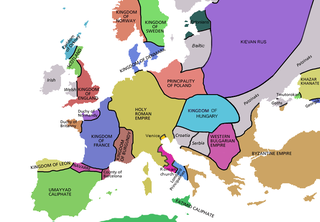 W
WThe Earldom of Orkney was a Norse feudal dignity in Scotland which had its origins from the Viking period. In the ninth and tenth centuries it covered more than the Northern Isles (Norðreyjar) and included Orkney, Shetland, Caithness, and Sutherland. The ruling position of Jarl or Earl of Orkney was heritable.
 W
WThe Farfarers: Before the Norse is a non-fiction book by Farley Mowat, setting out a theory about pre-Columbian trans-oceanic contact. Mowat's thesis is that even before the Vikings, North America was discovered and settled by Europeans originating from Orkney who reached Canada after a generation-spanning migration that used Iceland and Greenland as 'stepping stones'. Mowat's ideas are controversial and have been accused of being over-speculative. The book has been published in the UK as The Alban Quest.
 W
WHarald I Fairhair is portrayed by medieval Norwegian historians as the first King of Norway. According to traditions current in Norway and Iceland in the twelfth and thirteenth centuries, he reigned from c. 872 to 930. Supposedly, two of his sons, Eric Bloodaxe and Haakon the Good, succeeded Harald to become kings after his death.
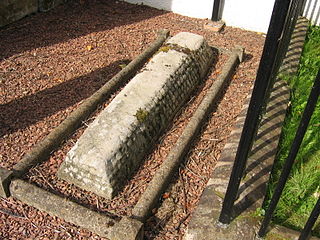 W
WHogbacks are stone carved Anglo-Scandinavian sculptures from 10th- to 12th-century England and Scotland. Singular hogbacks were found in Ireland and Wales. Hogbacks fell out of fashion by the beginning of the 11th century. Their function is generally accepted as grave markers.
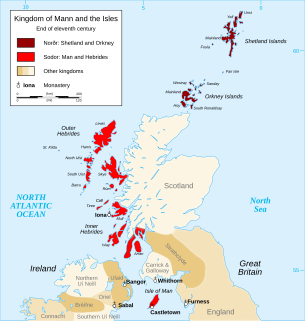 W
WThe Kingdom of the Isles consisted of the Isle of Man, the Hebrides and the islands of the Firth of Clyde from the 9th to the 13th centuries AD. The islands were known to the Norse as the Suðreyjar, or "Southern Isles" as distinct from the Norðreyjar or Northern Isles of Orkney and Shetland. In Scottish Gaelic, the kingdom is known as Rìoghachd nan Eilean. The historical record is incomplete, and the kingdom was not a continuous entity throughout the entire period. The islands concerned are sometimes referred to as the Kingdom of Mann and the Isles, although only some of the later rulers claimed that title. At times the rulers were independent of external control, although for much of the period they had overlords in Norway, Ireland, England, Scotland or Orkney. At times there also appear to have been competing claims for all or parts of the territory. The islands involved have a total land area of over 8,300 square kilometres (3,205 sq mi) and extend for more than 500 kilometres (310 mi) from north to south.
 W
WKári Sölmundarson was a Hebridean viking and soldier of fortune who lived in the late tenth and early eleventh centuries. He is a major character in Njál's Saga. Kári was the son of Solmund, who was the son of Thorbjorn "Jarl's Champion," an Icelander exiled before the establishment of the Althing for murder.
 W
WNa Renna, or the Kingdom of the Rhinns, was a Norse-Gaelic lordship which appears in 11th century records. The Rhinns was a province in Medieval Scotland, and comprised, along with Farines, the later Wigtownshire. The Martyrology of Óengus gives some idea of the kingdom's domain in the 11th century, as Dún Reichet (Dunragit) and Futerna (Whithorn) are said to lie in the kingdom, implying that it embraced the whole of later Wigtownshire.
 W
WThe Battle of Largs was an indecisive engagement between the kingdoms of Norway and Scotland, on the Firth of Clyde near Largs, Scotland. The conflict formed part of the Norwegian expedition against Scotland in 1263, in which Haakon Haakonsson, King of Norway attempted to reassert Norwegian sovereignty over the western seaboard of Scotland. Since the beginning of the 12th century this region had lain within the Norwegian realm, ruled by magnates who recognised the overlordship of the kings of Norway. In the mid-13th century, two Scottish kings, Alexander II and his son Alexander III, attempted to incorporate the region into their own realm. Following failed attempts to purchase the islands from the Norwegian king, the Scots launched military operations. Haakon responded to the Scottish aggression by leading a massive fleet from Norway, which reached the Hebrides in the summer of 1263. By the end of September, Haakon's fleet occupied the Firth of Clyde, and when negotiations between the kingdoms broke down, he brought the bulk of his fleet to anchor off the Cumbraes.
 W
WThe Lewis chessmen or Uig chessmen, named after the island or the bay where they were found, are a group of distinctive 12th-century chess pieces, along with other game pieces, most of which are carved from walrus ivory. Discovered in 1831 on Lewis in the Outer Hebrides of Scotland, they may constitute some of the few complete, surviving medieval chess sets, although it is not clear if a set as originally made can be assembled from the pieces. When found, the hoard contained 93 artifacts: 78 chess pieces, 14 tablemen and one belt buckle. Today, 82 pieces are owned and usually exhibited by the British Museum in London, and the remaining 11 are at the National Museum of Scotland in Edinburgh.
 W
WThe ninety-three game pieces of the Lewis chessmen hoard were found on the Isle of Lewis in the Outer Hebrides of Scotland. Medieval in origin, they were first exhibited in Edinburgh in 1831 but it is unclear how much earlier they had been discovered. The hoard comprised seventy-eight distinctive chess pieces and fifteen other non-chess pieces, nearly all carved from walrus tusk ivory, and they are now displayed at the British Museum in London and National Museums Scotland in Edinburgh. Another chess piece, which turned up in 1964 and in 2019 was attributed to have come from the original hoard, now belongs to an undisclosed owner.
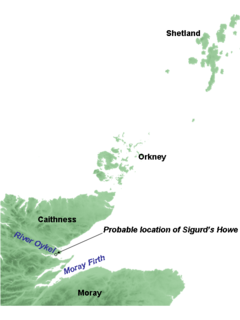 W
WMáel Brigte, also known as Máel Brigte the Bucktoothed or Máel Brigte Tusk was a 9th-century Pictish nobleman, most probably a Mormaer of Moray. He was responsible – in a bizarre posthumous incident – for the death of Sigurd the Mighty, Earl of Orkney.
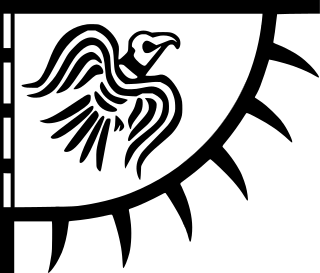 W
WThe Mormaer of Caithness was a vassal title mostly held by members of the Norwegian nobility based in Orkney from the Viking Age until 1350. The mormaerdom was held as fief of Scotland and the title was frequently held by the Norse Earls of Orkney, who were thus a vassal of both the King of Norway and the King of Scots. There is no other example in the history of either Norway or of Scotland in which a dynasty of earls owed their allegiance to two different kings.
 W
WAnn Naddodsdóttir was possibly a daughter of Naddoddr, the Viking attributed with the discovery of Iceland.
 W
WNorn is an extinct North Germanic language that was spoken in the Northern Isles off the north coast of mainland Scotland and in Caithness in the far north of the Scottish mainland. After Orkney and Shetland were pledged to Scotland by Norway in 1468–69, it was gradually replaced by Scots. Norn is thought to have become extinct in 1850, after the death of Walter Sutherland, the language's last known speaker.
 W
WViking activity in the British Isles occurred during the Early Middle Ages, the 8th to the 10th centuries, when Norsemen from Scandinavia travelled to Great Britain and Ireland to settle, trade or raid. Those who came to the British Isles have been generally referred to as Vikings, but some scholars debate whether the term Viking represented all Norse settlers or just those who raided.
 W
WThe Norse–Gaels were a people of mixed Gaelic and Norse ancestry and culture. They emerged in the Viking Age, when Vikings who settled in Ireland and in Scotland adopted Gaelic culture and intermarried with Gaels. The Norse–Gaels dominated much of the Irish Sea and Scottish Sea regions from the 9th to 12th centuries. They founded the Kingdom of the Isles, the Kingdom of Dublin, the Lordship of Galloway, and a Norse-Gaelic family briefly ruled the Kingdom of York. The most powerful Norse–Gaelic dynasty were the Uí Ímair or House of Ivar.
 W
WThe Norsemen were a North Germanic ethnolinguistic group of the Early Middle Ages, during which they spoke the Old Norse language. The language belongs to the North Germanic branch of the Indo-European languages and is the predecessor of the modern Germanic languages of Scandinavia. During the late 8th century, Norsemen embarked on a large-scale expansion in all directions, giving rise to the Viking Age. In English-language scholarship since the 19th century, Norse seafaring traders, settlers and warriors have commonly been referred to as Vikings. The identity of Norsemen derived into their modern descendants, the Danes, Icelanders, Faroe Islanders, Norwegians, and Swedes, who are now generally referred to as 'Scandinavians' rather than Norsemen.
 W
WThe Earl of Orkney was originally a Norse jarl ruling the archipelagos of Orkney and Shetland (Norðreyjar). Originally founded by Norse invaders, the status of the rulers of the Norðreyjar as Norwegian vassals was formalised in 1195. Although the Old Norse term jarl is etymologically related to "earl", and the jarls were succeeded by earls in the late 15th century, a Norwegian jarl is not the same thing. In the Norse context the distinction between jarls and kings did not become significant until the late 11th century and the early jarls would therefore have had considerable independence of action until that time. The position of Jarl of Orkney was eventually the most senior rank in mediaeval Norway except for the king himself.
 W
WThe Orkneyinga saga is a historical narrative of the history of the Orkney and Shetland islands and their relationship with other local polities, particularly Norway and Scotland. The saga has "no parallel in the social and literary record of Scotland" and is "the only medieval chronicle to have Orkney as the central place of action". The main focus of the work is the line of jarls who ruled the Earldom of Orkney, which constituted the Norðreyjar or Northern Isles of both Orkney and Shetland and there are frequent references to both archipelagoes throughout.
 W
WThe remains of the Orphir Round Church, dedicated to Saint Nicholas, are located in Orphir Parish on the Mainland of Orkney, Scotland. It is thought to have been built by jarl (earl) Haakon Paulsson as penance for murdering his cousin and co-ruler Magnus Erlendsson in the late 11th or early 12th century. According to the Orkneyinga saga, earl Haakon took sole power in 1117 after the killing of Magnus, and the round kirk was later rededicated to St Magnus. The saga refers to a "large drinking-hall" with a "magnificent church" nearby. The remains of the drinking hall, known as the Earl's Bu, can still be seen, as well as a later Norse horizontal watermill.
 W
WThe Port an Eilean Mhòir ship burial is a Viking boat burial site in Ardnamurchan, Scotland, the most westerly point on the island of Great Britain. Dated to the 10th century, the burial consists of a Viking boat about 5 metres (16 ft) long by 1.5 metres (4.9 ft) wide in which a man was laid to rest with his shield, sword and spear as well as other grave goods.
 W
WThe Royal Scots Navy was the navy of the Kingdom of Scotland from its origins in the Middle Ages until its merger with the Kingdom of England's Royal Navy per the Acts of Union 1707. There are mentions in Medieval records of fleets commanded by Scottish kings in the twelfth and thirteenth centuries. King Robert I, developed naval power to counter the English in the Wars of Independence (1296–1328), and after the establishment of Scottish independence continued to build up naval capacity. In the late fourteenth century naval warfare with England was conducted largely by hired Scots, Flemish and French merchantmen and privateers. King James I, took a greater interest in naval power establishing a shipbuilding yard at Leith and probably created the office of Lord High Admiral.
 W
WEiríks saga rauða or the Saga of Erik the Red is a saga on the Norse exploration of North-America. The original saga is thought to have been written in the 13th century. The saga is preserved in two manuscripts in somewhat different versions; Hauksbók and Skálholtsbók.
 W
WSt Magnus's Church on Egilsay, one of the Orkney Islands in Scotland, dates back to the 12th century and early Norse times. Although it is a roofless ruin, it is remarkably complete, and is described by Historic Environment Scotland (HES) as second only to St Magnus Cathedral, Kirkwall, as a surviving Norse church in Scotland.
 W
WThe Scar boat burial is a Viking boat burial near the village of Scar, on Sanday, in Orkney, Scotland. The burial, which dates to between 875 and 950 AD, contained the remains of a man, an elderly woman, and a child, along with numerous grave goods. Although the site had to be excavated quickly because of the threat of coastal erosion owing to bad weather conditions, it yielded many important finds.
 W
WSén dollotar Ulaid ... is an Irish poem of uncertain date, possibly early 10th-century. It consists of nine quatrains, and lacks context. It appears to concern a raid by the men of Ulaid (Ulster) to Viking Scotland.
 W
WThe Bay of Skaill is a small bay on the west coast of the Orkney Mainland, Scotland.
 W
WThe Uí (h)Ímair [iː ˈiːvˠaɾʲ] (listen), or Dynasty of Ivar, was a royal Norse-Gael dynasty which ruled much of the Irish Sea region, the Kingdom of Dublin, the western coast of Scotland, including the Hebrides and some part of Northern England, from the mid 9th century.
 W
WViking expansion is the process by which Norse explorers, traders and warriors, the latter known in modern scholarship as Vikings, sailed most of the North Atlantic, reaching south to North Africa and east to Russia, Constantinople and the Middle East as looters, traders, colonists and mercenaries. Vikings under Leif Erikson, the heir to Erik the Red, reached North America and set up a short-lived settlement in present-day L'Anse aux Meadows, Newfoundland, Canada. Longer lasting and more established settlements were formed in Greenland, Iceland, the Faroe Islands, Great Britain, Ireland and Normandy.
 W
WWyre is one of the Orkney Islands, lying south-east of Rousay. It is 311 hectares (1.20 sq mi) and 32 metres (105 ft) at its highest point. It is one of the smallest inhabited islands in the archipelago.